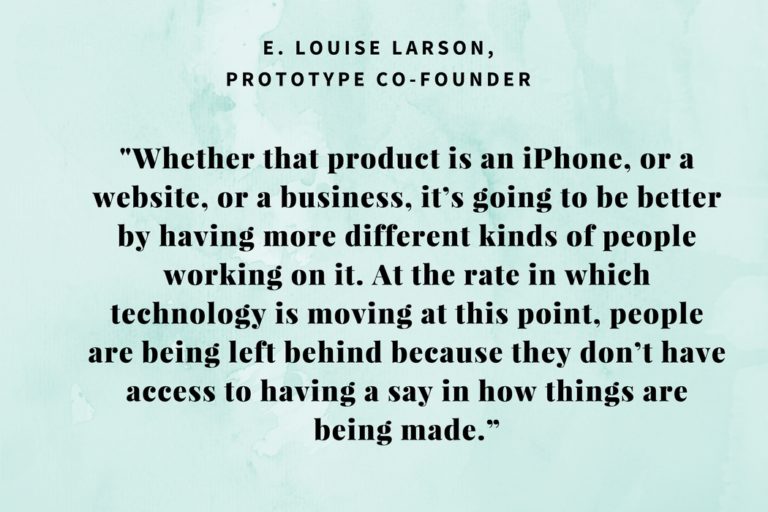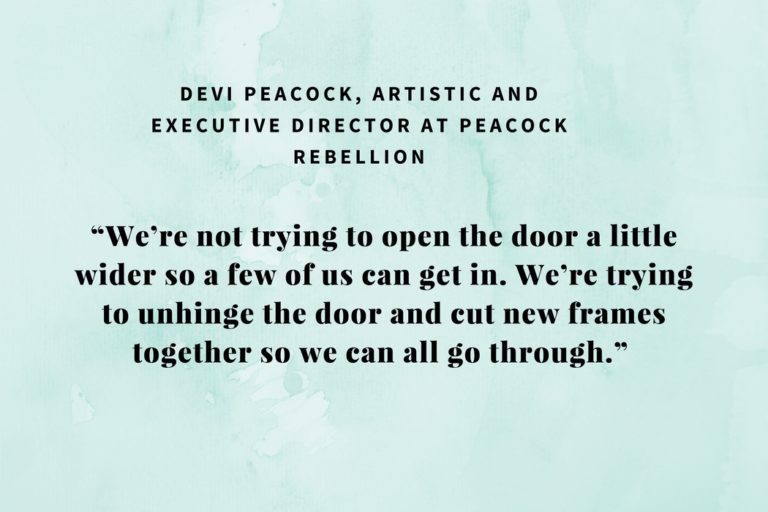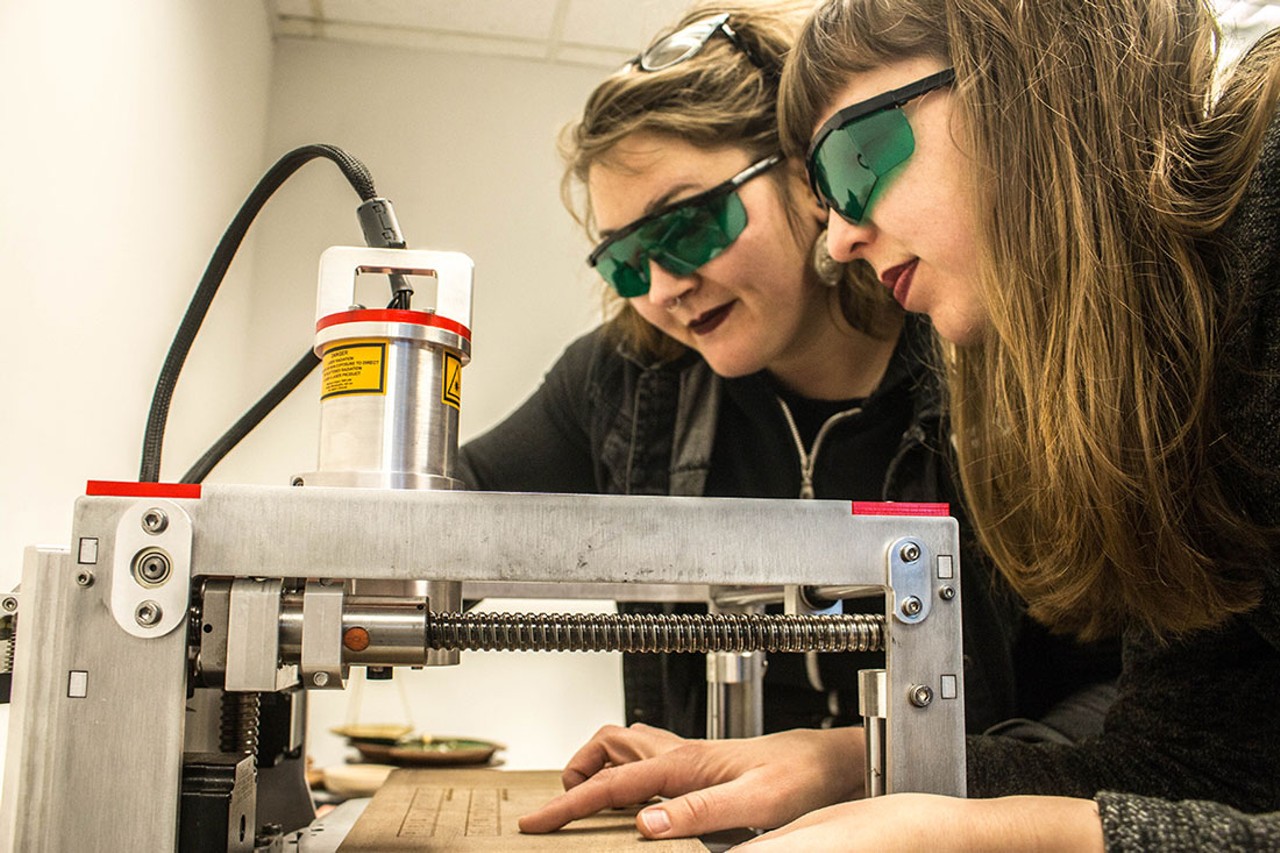Across the country, feminist maker spaces are helping women, trans people and people of color cultivate and craft skills, like salary negotiation to metalworking, in their own safe space.
by Amanda Reed
Photos Courtesy of Prototype
Terry Nordbrock, a volunteer and board member at Xerocraft, a maker and hackerspace in Tucson, Arizona, has her fair share of stories to tell when it comes to the exclusion of women in makerspaces.
When she was a robotics coach in 2011 and used Xerocraft as a meeting space for her team—made up of both young men and women—her female students sometimes shied away from using the equipment and focused on more logistical aspects of the team, like booking travel. Nordbrock encouraged them to use some of the tools in the shop, like metal lathes, but even then they faced assumptive challenges. According to Nordbrock, the male students were left alone while the female students were approached to get help they didn’t need.
Nordbrock herself faced this when she began volunteering in the space in 2013 and earned certifications to use some the space’s tools. During her certification test to use to use the shop’s laser cutter, three men approached her to show her how to work the machine—all while the test proctor was observing Nordbrock.
“There’s some unspoken societal rules that have to do with makerspaces, and it ends up being why there are more men in engineering, or why there are more men showing up to a makerspace,” says Nordbrock. “These unspoken rules assign gender to the use of tools or the ability to make and design things.”
Eventually, Xerocraft offered a WTF Night—short for Women, Trans, Femme—an open hack night on Tuesdays where women, trans and femme-identifying persons can come to the space and work, all without the sometimes demeaning help from men.
It’s a move that Nordbrock says has helped increase the amount of women and trans people in the space.
All across the country, these feminist makerspaces—places where women, trans people, femme-identifying people, women of color or anyone who identifies as a feminist—allow women and non-binary people to build the confidence to create and craft in an otherwise male-dominated space, creating more diversity in technology and acting as a welcome mat into STEM fields.
History of Makerspaces
Makerspaces were inspired by hacklabs, community spaces where technology was altered—or “hacked”—in order to perform alternative tasks in the 1990s. Most of these spaces were run by volunteers and provided free public access to computers and the Internet. Generally, they used reclaimed and recycled computers to run software, and provided computer access to those who were interested in hacking. Like the makerspaces of today, hacklabs ran workshops on basic computer use, installing software, programming, electronics and independent radio broadcast.
The first hacklabs appeared in Europe—often in empty buildings—and had political ties: In Italy, hacklabs were tied to autonomist movement, and were associated with anarchism in Spain, Germany and the Netherlands. Personal computers were seen as a way to organize political groups, since all the person needed was an Internet connection to access information. Hacklabs mostly served media activists and squatters—someone who occupies in a building they do not rent, own or have permission to use, which is rooted in the anarchist, automist and socialist political movements. Media activists used the spaces to convene, learn, produce and teach, while squatters used hacklabs to get access to the Internet.
Hacklabs evolved into hackerspaces in the late 1990s, which had a similar community hacking mindset without the political ties. The beginning of hackerspaces can be traced back to 1995 Berlin when the world’s first hackerspace, called C-Base, was launched.
Around the mid-2000s, these spaces were broadened to include making of any kind. Most of them include different materials to create, like knitting needles and yarn, 3D printers, laser cutters and even tables with LEGOs. Similar to their hacklab origins, makerspaces can be installed almost anywhere. There are more than 1,300 makerspaces worldwide in libraries, schools, museums and community spaces.
But, as the rise of the maker movement entered the late aughts, many women noticed the lack of women in these spaces despite their deep history in computing and tech.
“We know that women and people of color have been making things literally since the beginning of time, and that there are tons of women and people of color who are interested in tech, and interested in this growing tech scene in Pittsburgh, so we were like, ‘how can we create a space that would be more welcoming and engaging of diverse communities?’” says Erin Oldynski, co-founder of Prototype, a feminist makerspace in Pittsburgh established in January 2017 after receiving a $5,000 grant through The Sprout Fund, a Pittsburgh agency that gives out grants to projects and initiatives that catalyze change in the area.
Specifically, the grant was through the Sprout Fund’s 100 Days initiative, put in place after President’s Trump’s inauguration as a local response to national concerns.
Much like their hacklab origins, most feminist makerspaces have political ties: the word “feminist” itself has deep roots in political ideologies as early as 1792 with the publication of Mary Wollstonecraft’s “A Vindication of the Rights of Woman.” Many feminist issues—like gender equality, ending the wage gap and trans rights—are intrinsically political issues, since they are almost always controlled by the government, like access to reproductive services.
“What we’re thinking about is what it’s like to actually thrive, and how to dream and prototype trans liberation, and how to practice that, and what is it like to 3D model that,” says Devi Peacock, artistic and executive director at Peacock Rebellion, a San Francisco Bay Area queer and trans art collective. The space is home to Liberating Ourselves Locally (LOL), a queer and trans people of color-centered makerspace for social justice.
The space uses tools found in traditional makerspaces to create conscious art. According to Peacock, one person used the space’s industrial sewing machine to create “fashion against fascism.” The space allows trans and queer people to learn how to install LED lights in signs so they can be seen during night protests. One board member video called in from the Pacific Northwest to teach members how to use Twitch to design videogames to link trans liberation, disability justice and black liberation.
“If we don’t create the spaces ourselves, then they’re not going to be created for us,” Peacock says.
Women’s exclusion in makerspaces
According to a report by Dr. Jen Lewis, founder of UK women-in-science support network Science Grrl, and Access Space, a UK charity aimed at educating the public on matters of information technology, women often lack role models in STEM fields. Women make up 48 percent of the workforce, but only make up 24 percent of STEM workers. People who identify with those identities cannot picture themselves working in those professions, and thus reject science and technology at a young age since it is not “for girls.”
Beyond this, trans people and people of color face even smaller representation in STEM fields. According to the Queer in STEM survey, 3.5% of Americans identify as LGBTQ+. However, outside of that figure, not much is known about the number of LGBTQ+ in STEM. The National Science Foundation regularly reports on the state of women, minorities, and persons with disabilities in STEM fields, but does not include LGBTQ+ people in the research.
On top of this, there are not many programs for older women to learn STEM skills.
“Adult education has the potential to play an extremely important role in reducing unemployment by giving unemployed, working age adults a broader skill set, and one that not only applies to in-demand and growing industries, but that also better equips people to self-employ through freelancing or developing independent small business,” Lewis writes.
Feminist makerspaces help lower the barrier to entry into STEM for women and non-binary people by providing free or low-cost workshops to learn makers skills like coding, soldering, 3D printing, laser cutting, woodworking and even salary negotiation. All of which they could use in tech.
“It does seem to make individuals more attractive to employers who have these hands-on skills,” says Nordbrock.
However, feminist makerspaces don’t provide everything someone needs to know in order to pursue a tech job.
“We provide an entry point for what you want to learn and how you can learn fun and interesting things with a network of support,” says E. Louise Larson, Prototype co-founder.
“You’re not going to learn everything you need to learn at Prototype,” says Oldynski.

Instead, feminist makerspaces help unite people with similar backgrounds in order to network and learn different skills.
“The thing about getting jobs is also about networking, and people can build relationships here with other people who actually believe in social justice and equity,” Peacock says.
Colette Taylor, a founding member of The Attic, a feminist makerspace in Seattle, Washington, had coding skills, but the networking opportunities in the space helped her find a job.
“I got one of my jobs through The Attic because I was a hobbyist coder and there was someone who made some introductions,” she says.
Although feminist makerspaces won’t teach someone everything they need to know in order to find a job in STEM, the spaces do teach women and trans folks something that’s not taught in college: confidence.
“We have people who come to our workshops who have never used a power drill or never written code or never touched a saw before, and they leave our workshops saying, ‘this is something I could do, and it’s not so intimidating after all.’ And that experience, we hope, leads them to pursue further education or training or jobs where they can develop those skills, or to start their own businesses,” Oldynski says.
“We had a lot of people who were scared of technology and things like that, and both introducing them to the fact that they don’t need to be scared of tech and could learn to code and teaching them they didn’t need to feel shame if they didn’t want to learn code,” Taylor says.
This confidence helps women and trans people pursue careers in STEM, which helps promote diversity in technology.
According to the National Center for Women and Information Technology, companies who have gender-diverse work teams have higher sales revenue, more customers, higher productivity and greater profits than non-diverse companies.
But, according to Larson, diversity and technology improves the quality and usability of an object since people from different educational backgrounds and experiences are working on it.

“If you have one specific type of people that are in control of something, they design and create and produce and market and iterate on that thing as they understand it, and so it becomes specific to that demographic. Whether that product is an iPhone, or a website, or a business, it’s going to be better by having more different kinds of people working on it,” says Larson. “At the rate in which technology is moving at this point, people are being left behind because they don’t have access to having a say in how things are being made.”
Because of this emphasis on diversity in technology, the goal of feminist makerspaces as a springboard into STEM is not to fill quotas in tech companies—it’s to level the playing field with their white, male counterparts completely.
“We’re not trying to open the door a little wider so a few of us can get in,” says Peacock. “We’re trying to unhinge the door and cut new frames together so we can all go through.”


Amanda Reed is a Pittsburgh-based journalist who proudly owns a faux fur cheetah print coat and hopes to put “lives with her two cats in Brooklyn” in the author bio of her debut book. Follow her on @reedkat_ and read more of her work at amandajreed.weebly.com.




